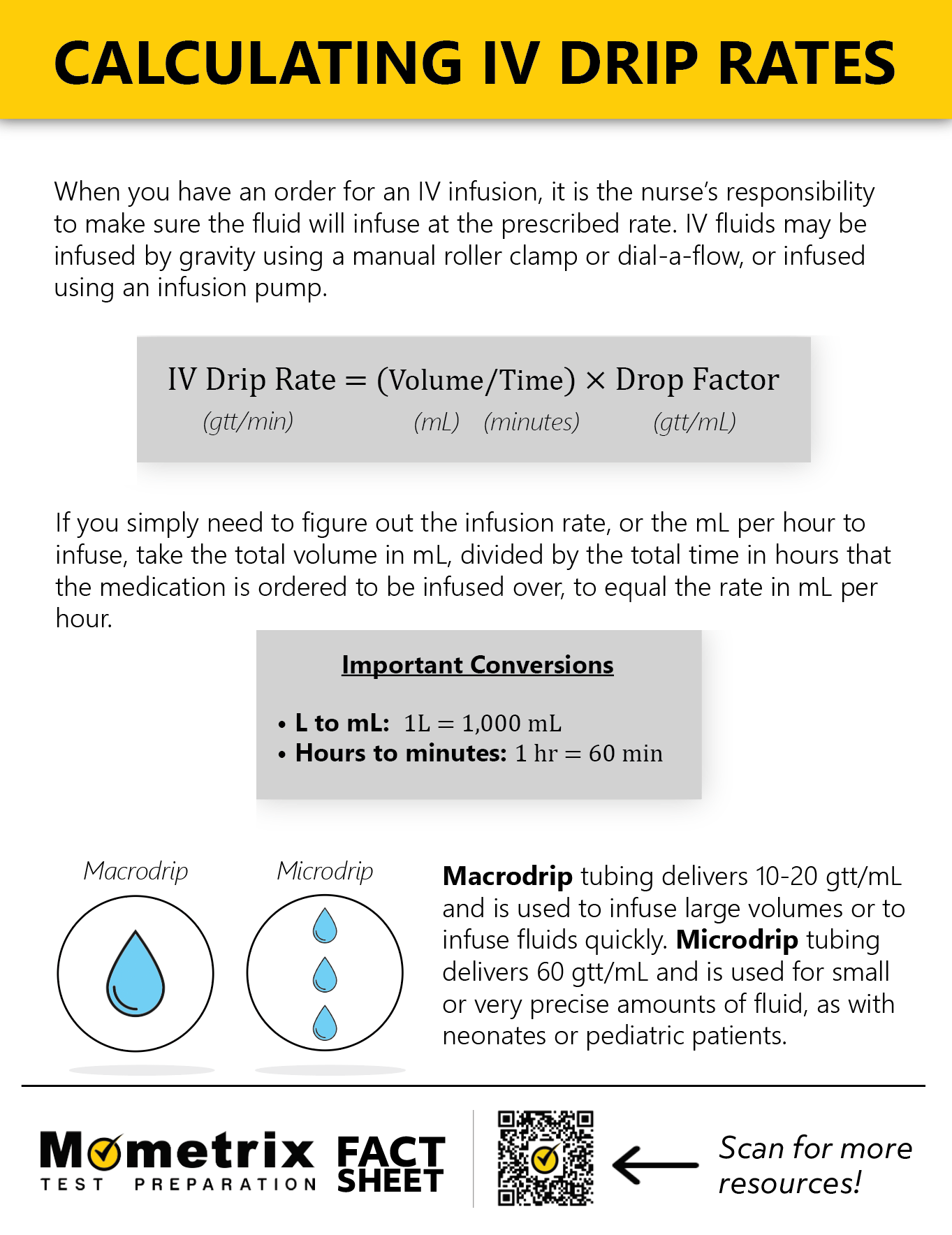
Welcome to this video on calculating IV drip rates.
When you have an order for an IV infusion, it is the nurse’s responsibility to make sure the fluid will infuse at the prescribed rate. IV fluids may be infused by gravity using a manual roller clamp or dial-a-flow, or infused using an infusion pump. Regardless of the method, it is important to know how to calculate the correct IV drip rate.
Types of IV Tubing and Drop Factors
When calculating the drip rate, first identify which IV tubing you will be using, microdrip or macrodrip, so you can use the proper drop factor in your calculations. The drop factor is the number of drops in one mL of solution and is printed on the IV tubing package.
Macrodrip and microdrip refers to the diameter of the needle where the drop enters the drip chamber. Macrodrip tubing generally delivers 10 to 20 gtt/mL and is used to infuse large volumes or to infuse fluids quickly. Microdrip tubing delivers 60 gtt/mL and is used for small or very precise amounts of fluid, as with neonates or pediatric patients.
Calculating IV Drip Rates
If you simply need to figure out the infusion rate, or the mL per hour to infuse, take the total volume in mL, divided by the total time in hours that the medication is ordered to be infused over, to equal the rate in mL per hour. For example, if you have 1,000 mL Normal Saline to infuse over 8 hours, take 1,000 mL divided by 8 hours, to equal 125 mL/hr.
To calculate the drip rate, however, the drop factor is needed. The formula for calculating the IV drip rate is… total volume (in mL) divided by time (in minutes), multiplied by the drop factor (in gtt/mL), which equals the IV drip rate in gtt/min.
Examples of IV Drip Rate Calculations
Macrodrip Tubing Example: Lactated Ringers
Let’s try an example.
The provider has ordered 1,000 mL Lactated Ringers to infuse over 8 hours. You have a macrodrip tubing with a drop factor of 15 gtt/mL. Calculate how many gtt/min to set as the IV flow rate. Using the formula, 1,000 mL divided by \(8\times 60\) (since we have 8 hours times 60min/hr), then multiply by 15 gtt/min to equal 31.2, rounded to 31 gtt/min.
Microdrip Tubing Example: Small Volume Infusion
Here’s a tip: When the IV tubing is microdrip, 60 gtt/mL, the drops per minute will be the same as the mL per hour. For example, you have 500 mL to infuse over 12 hours with a microdrip set. The total volume (500 mL), divided by the total time in hours (12), equals 41.6, rounded to 42 mL per hour.
The drops per minute would be calculated as total volume, divided by time (in minutes), multiplied by the drop factor of 60 gtts/min, which also equals 41.6, rounded to 42 drops per minute.
IV Piggyback Medication Example: Ancef
Let’s look at an example of an IV piggyback medication.
1 gram of Ancef in 100 mL of normal saline is to be infused over 30 minutes. You have macrodrip tubing with a drop factor of 10 gtt/mL. Calculate how many gtt/min to set as the IV drip rate. Use the formula, with 100 mL divided by 30 min, multiplied by 10 gtt/min, which equals 33.3, rounded to 33 gtt/min.
Using IV Infusion Pumps
If you need to set this up on an IV infusion pump, use the formula, volume (mL) divided by time (min), multiplied by 60 min over 1 hour. This equals the IV flow rate in mL/hr which is the standard method of setting infusion rates on IV pumps. Using this formula, 100 mL divided by 30 min, times 60 min in 1 hr, equals 199.9, rounded to 200 mL/hr.
Monitoring Infusion Accuracy
Once the infusion has started, monitor the rate closely to be sure it is infusing at the correct rate and check the patient’s IV site for signs of infiltration or inflammation.
That’s all for this review! Thanks for watching, and happy studying.
Frequently Asked Questions
Q
What is an IV drip rate?
A
An IV drip rate is a way of describing the rate of an intravenous infusion based on the number of drops (gtt) that are administered to the patient per minute. This is influenced by the type of the tubing (microdrip or macrodrip), the total volume that is required to be infused, and the time over which the infusion is ordered to run.
Q
What is an IV drop factor?
A
An IV drop factor reflects the specific size of the drops of IV fluid that the tubing set creates. This is a predetermined number based on the tubing required and available to administer the medication. Tubing can be either microdrip or macrodrip.
Q
What is the difference between a microdrip and macrodrip IV tubing?
A
Microdrip IV tubing creates extremely small drip sizes for medications that are potent and must be carefully administered and/or for patient populations that are highly sensitive to large doses of medications (namely, neonatal and pediatric patients). The microdrip drip factor is generally estimated at 60 gtt/mL.
Macrodrip IV tubing is the more standard tubing type, and has larger drops of fluid than microdrip tubing. The macrodrip drip factor is generally somewhere between 10 and 20 gtt/mL.
Q
How do you calculate an IV drip rate?
A
IV drip rate is calculated by this formula:
\(\text{total volume } (mL)/\text{time } (min) \times \text{ drop factor } (gtt/mL)\)
This equation can also be rearranged to calculate the time required for an infusion, when provided the volume to be infused, the drip rate, and the drop factor.
If you need some extra help, try out our IV drip rate calculator!


